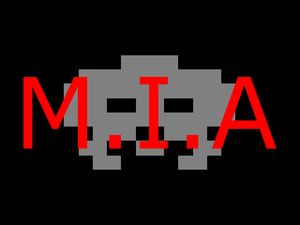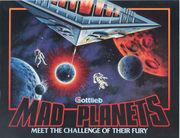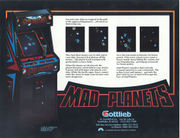Lost In Translation/Mad Planets
| Mad Planets | |
|---|---|
| Manufacturer | Gottlieb |
| Released | 1983 |
| Control Method |
8-way Joystick Dial 2 Button(s) |
| Main CPU | 8088 (@ 5.000 MHz) M6502 (@ 894.886 kHz) |
| Sound CPU | Mono DAC |
| Video Details |
Raster (Vertical) 256 x 240 pixels 61.00 Hz 16 Palette colours |
| Screens | 1 |
| ROM Info | 13 ROMs 86,016 bytes (84.00 KiB) |
| MAME ID | mplanets · mplanuk |
About The Game
Mad Planets is an arcade video game where the player takes control of a spaceship and must attempt to destroy a series of Earth-like planets which emerge from the center of the screen and rapidly move towards the player's ship - increasing in size as they do so. Destroying all of the planets in a round before the they reach their full scale will see the player awarded with bonus points. Fully-grown planets are orbited by a number of small moons, which, if destroyed, cause the planet to go 'mad' - turning red and making a beeline for the player's ship. The game also includes bonus rounds in which stranded astronauts can be rescued for additional points.
Additional Technical Information
The control panel consists of 1 or 2 player select buttons, a joystick with fire button and one rotary encoder (spinner) for rotating the ship. The players ship is moved vertically, horizontally or diagonally by the joystick. The ship can be rotated 360 degrees by the rotary dial. The fire button is a trigger styled switch located on the joystick.
Trivia
Released in February 1983. Approximately 1,500 units were produced.
At the time of Mad Planets, most video games did not include the designers names, as many companies feared that well-known designers would be lured away by competitors. This policy approached ridiculous heights in an April 1983 Videogames magazine interview with Davis, Thiel and Lee. While designers from Williams were identified by name in the same issue, the Gottlieb trio was identified as D. Ziner, J. Walkman, and R. Teeste - due to the company's policy of keeping designers' names secret. While management continued to prevent employees from including their full names in a game, they DID eventually agree to a small compromise by allowing the use of their initials (or nicknames) for the game's default high scores. In Mad Planets, the default high score screen contains the identities of almost the entire Gottlieb video crew.
Jean Baudin holds the official record for this game with 507,710 points on August 12, 2001.
2 Mad Planets machines were shown at the 2003 classic arcade games show 'California Extreme' in San Jose, California.
While Mad Planets, in its original form, was never ported across to any of the home machines of the time, a British programmer called Simon Nicol wrote an almost identical version called 'Crazy Comets', for the Commodore 64. It looked and played exactly like the arcade game that inspired it, but featured far superior music - written by industry legend, Rob Hubbard - which became celebrated in its own right.
Scoring
Approaching Planets
These planets first appear far in another galaxy and rapidly approach the players ship. They do not have moons orbiting around them. The player is awarded 100 points for destroying an Approaching Planet.
Attacking Planet
A planet that has 3 to 6 moons orbiting around it. An attacking Planet seeks out and tries to destroy the players ship by colliding with the ship or releasing moons into space. An Attacking Planet cannot be destroyed until all of the orbiting moons have been destroyed (see MAD PLANET). An Attacking Planet scores 1 point when hit.
Oribiting Moon
These are moons that are in orbit around the Attacking Planet. Destroying an Orbiting Moon awards 10 points.
Mad Moon
Any moon that leaves its original orbit around the planet and is free floating in space. These orange moons must be avoided or destroyed. Destroying a Mad Moon scores 100 points and is eliminated from the planet that released it. If the Mad Moon escapes the player and moves off the screen, it is replaced in its original orbit around the Attacking Planet.
Mad Planet
Commencing with the destruction of all of the Orbiting Moons, an Attacking Planet transposes into a Mad Planet. A Mad Planet must be destroyed quickly as its vengeful quest to destroy the ship causes its movement to quicken rapidly. Mad Planets score dependent on its size :
- Mad Plutona : 200 points
- Mad Marzon : 300 points
- Mad Kryptophan : 500 points
Comets
Comets first appear in the beginning of the third round and continue throughout the game. They travel indiscriminately around the planets and are deadly to the players ship. It must be avoided or destroyed. The first Comet destroyed awards 100 points. Every Comet destroyed in succession increments its value by 100 points up to 1000 points awarded for the tenth and all following Comets. However, if a Comet is allowed to leave the screen at any time during the round, the Comet values start over at 100 points and repeat the scoring sequence. This scoring sequence repeats at the beginning of each new round.
Humans
Humans first appear in the first Bonus Period (see BONUS PERIOD) and all subsequent rounds thereafter. Humans are picked up by the players ship by touching them with the ship. Points awarded for picking up Humans advances for each wave of game play. Starting with the second wave, Humans award 300 points each. This increments by 100 points for each subsequent wave to a maximum of 1000 points per Human in the ninth wave and remains at 1000 points for the remainder of the game. During a Bonus Period, all Humans score 200 points (see BONUS PERIOD).
Bonus Period
A Bonus Period is achieved at the end of each wave (see ROUND PROGRESSION). During the Bonus Period only the players ship, Humans and Comets appear on the screen. The Player must pick up Humans to gain bonus points and avoid being hit by the Comet. The period ends when either the players ship is destroyed by a Comet, the Comet is allowed to leave the screen or ten Comets have been destroyed. Each Comet appearing (up to 10) must be destroyed for the Bonus Period to continue. Comets score 100 points for the first one destroyed and increment by 100 points for each subsequent Comet that is eliminated. All Humans score 200 points during the Bonus Period.
Perfect Round
A Perfect Round is achieved by destroying all of the planets in a round while they are Approaching Planets. They must not be allowed to form into Attacking Planets and the players ship must not be destroyed. A Perfect Round awards the total number of Attacking Planets allowed to appear on the screen at one time for that round times 2000.
Round Progressions
Wave 1, Round 1
- Number of Attacking Planets : 2
- Total number of Planets in Round : 5
- Human points : ---
- Perfect Round Bonus : 4000
Wave 1, Round 2
- Number of Attacking Planets : 3
- Total number of Planets in Round : 6
- Human points : ---
- Perfect Round Bonus : 6000
Wave 1, Round 3
- Number of Attacking Planets : 4
- Total number of Planets in Round : 7
- Human points : ---
- Perfect Round Bonus : 8000
Wave 1, Bonus Period
- Human points : 200
Wave 2, Round 4
- Number of Attacking Planets : 2
- Total number of Planets in Round : 8
- Human points : 300
- Perfect Round Bonus : 4000
Wave 2, Round 5
- Number of Attacking Planets : 3
- Total number of Planets in Round : 9
- Human points : 300
- Perfect Round Bonus : 6000
Wave 2, Round 6
- Number of Attacking Planets : 4
- Total number of Planets in Round : 10
- Human points : 300
- Perfect Round Bonus : 8000
Wave 2, Bonus Period
- Human points : 300
Wave 3, Round 7
- Number of Attacking Planets : 2
- Total number of Planets in Round : 11
- Human points : 400
- Perfect Round Bonus : 4000
Wave 3, Round 8
- Number of Attacking Planets : 3
- Total number of Planets in Round : 12
- Human points : 400
- Perfect Round Bonus : 6000
Wave 3, Round 9
- Number of Attacking Planets : 4
- Total number of Planets in Round : 13
- Human points : 400
- Perfect Round Bonus : 8000
Wave 3, Bonus Period
- Human points : 200
Wave 4, Round 10
- Number of Attacking Planets : 2
- Total number of Planets in Round : 14
- Human points : 500
- Perfect Round Bonus : 4000
Wave 4, Round 11
- Number of Attacking Planets : 3
- Total number of Planets in Round : 15
- Human points : 500
- Perfect Round Bonus : 6000
Wave 4, Round 12
- Number of Attacking Planets : 4
- Total number of Planets in Round : 16
- Human points : 500
- Perfect Round Bonus : 8000
Wave 4, Bonus Period
- Human points : 200
Wave 5, Round 13
- Number of Attacking Planets : 2
- Total number of Planets in Round : 17
- Human points : 600
- Perfect Round Bonus : 4000
Wave 5, Round 14
- Number of Attacking Planets : 3
- Total number of Planets in Round : 18
- Human points : 600
- Perfect Round Bonus : 6000
Wave 5, Round 15
- Number of Attacking Planets : 4
- Total number of Planets in Round : 19
- Human points : 600
- Perfect Round Bonus : 8000
Wave 5, Round 16
- Number of Attacking Planets : 5
- Total number of Planets in Round : 20
- Human points : 600
- Perfect Round Bonus : 10,000
Wave 5, Bonus Period
- Human points : 200
Wave 6, Round 17
- Number of Attacking Planets : 2
- Total number of Planets in Round : 20
- Human points : 700
- Perfect Round Bonus : 4000
Wave 6, Round 18
- Number of Attacking Planets : 3
- Total number of Planets in Round : 20
- Human points : 700
- Perfect Round Bonus : 6000
Wave 6, Round 19
- Number of Attacking Planets : 4
- Total number of Planets in Round : 20
- Human points : 700
- Perfect Round Bonus : 8000
Wave 6, Round 20
- Number of Attacking Planets : 5
- Total number of Planets in Round : 20
- Human points : 700
- Perfect Round Bonus : 10,000
Wave 6, Bonus Period
- Human points : 200
Wave 7, Round 21
- Number of Attacking Planets : 2
- Total number of Planets in Round : 20
- Human points : 800
- Perfect Round Bonus : 4000
Wave 7, Round 22
- Number of Attacking Planets : 3
- Total number of Planets in Round : 20
- Human points : 800
- Perfect Round Bonus : 6000
Wave 7, Round 23
- Number of Attacking Planets : 4
- Total number of Planets in Round : 20
- Human points : 800
- Perfect Round Bonus : 8000
Wave 7, Round 24
- Number of Attacking Planets : 5
- Total number of Planets in Round : 20
- Human points : 800
- Perfect Round Bonus : 10,000
Wave 7, Bonus Period
- Human points : 200
Wave 8, Round 25
- Number of Attacking Planets : 2
- Total number of Planets in Round : 20
- Human points : 900
- Perfect Round Bonus : 4000
Wave 8, Round 26
- Number of Attacking Planets : 3
- Total number of Planets in Round : 20
- Human points : 900
- Perfect Round Bonus : 6000
Wave 8, Round 27
- Number of Attacking Planets : 4
- Total number of Planets in Round : 20
- Human points : 900
- Perfect Round Bonus : 8000
Wave 8, Round 28
- Number of Attacking Planets : 5
- Total number of Planets in Round : 20
- Human points : 900
- Perfect Round Bonus : 10,000
Wave 8, Bonus Period
- Human points : 200
Wave 9, Round 29
- Number of Attacking Planets : 2
- Total number of Planets in Round : 20
- Human points : 1000
- Perfect Round Bonus : 4000
Wave 9, Round 30
- Number of Attacking Planets : 3
- Total number of Planets in Round : 20
- Human points : 1000
- Perfect Round Bonus : 6000
Wave 9, Round 31
- Number of Attacking Planets : 4
- Total number of Planets in Round : 20
- Human points : 1000
- Perfect Round Bonus : 8000
Wave 9, Round 32
- Number of Attacking Planets : 5
- Total number of Planets in Round : 20
- Human points : 1000
- Perfect Round Bonus : 10,000
Wave 9, Bonus Period
- Human points : 200
Rounds 29 through 32 are repeated for rounds 33 through 99.
Tips and tricks
Game play is initiated when either the 1 player or 2 player buttons are pressed. As the round begins, Approaching Planets from a distant galaxy begin to approach the players ship. The player has the option of destroying the planets as they are approaching him. Successfully destroying all Approaching Planets in a round awards bonus points for a Perfect Round. When a planet is allowed to reach the players ships orbit, it reveals a group of moons orbiting around it. This becomes an Attacking Planet. An Attacking Planet cannot be destroyed until the player has destroyed all of its Orbiting Moons. Once all of the Orbiting Moons have been destroyed, the planet transposes into the Mad Planet destine to destroy the players ship. The Mad Planet must be destroyed quickly as it travels faster and faster the longer it remains in orbit.
Each round has a predetermined number of planets per round and a predetermined number of Attacking Planets to fight at one time (see ROUND PROGRESSIONS). Once an Attacking Planet is destroyed, another planet approaches. If not destroyed, it also will become an Attacking Planet. This cycle continues until there are no longer any planets to destroy in that round. Once all the planets have been destroyed, the game advances to the next round.
In defense to the players attack, the Attacking Planet will release one of its Orbiting Moons into space in an attempt to destroy the players ship. This orange moon must be avoided or destroyed. If the Mad Moon is allowed to leave the screen without being destroyed, it is replaced in its original orbit around the Attacking Planet that released it.
The Bonus Period appears at the end of each wave. During this time, the player must pick up Humans while trying to destroy as many Comets as possible. The period ends when either the players ship is destroyed by a Comet, the Comet is allowed to leave the screen or ten Comets have been destroyed (see BONUS PERIOD).
Staff
- Designed and Programmed By
- Kan Yabumoto
- Graphics By
- Jeff Lee
- Audio By
- David Thiel
- Hardware By
- Jun Yum
- Cabinet Graphics
- Terry Doerzaph
Cabinet and Artwork
Ports
- Computers
- Commodore C64 (1985, "Crazy Comets")







